Bulletin – June 2018 Global Economy Economic Trends in India
- Download 1MB
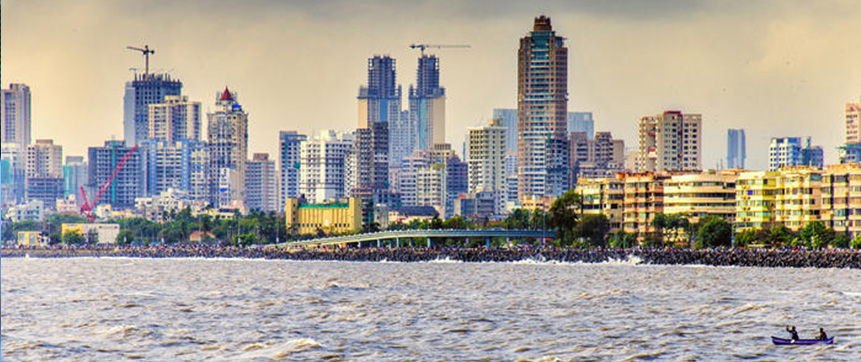
Abstract
The Indian economy has experienced a notable turnaround in recent years. Growth has rebounded, inflation has moderated, and the budget and trade deficits have narrowed. The Indian Government has also initiated policies and reforms aimed at encouraging investment, strengthening productivity and ensuring fiscal sustainability. Stronger growth in domestic demand has led to a recovery in India's imports, including from Australia. The recent volatility in foreign exchange markets and the recovery in oil prices pose upside risks to inflation and the current account deficit. However, India's strong long-term potential for growth, driven by demographics, urbanisation and productivity-enhancing reforms, suggests there is scope for trade between Australia and India to expand further in coming years.
Introduction
The Indian economy has experienced large swings in growth and inflation over the past decade (Graph 1). GDP growth weakened sharply during the global financial crisis (GFC) due to a decline in export demand from advanced economies and a slump in investment. Nonetheless, activity rebounded and high inflation became entrenched after the GFC, supported by an increase in government spending and expansionary monetary policy. While growth subsequently softened due to the withdrawal of stimulus and the rising price of crude oil, more recently, conditions have improved along several dimensions. GDP growth has trended higher, inflation has come down, external fragilities (relating to currency volatility and the size of the current account deficit) have abated and the fiscal position has become more sustainable.
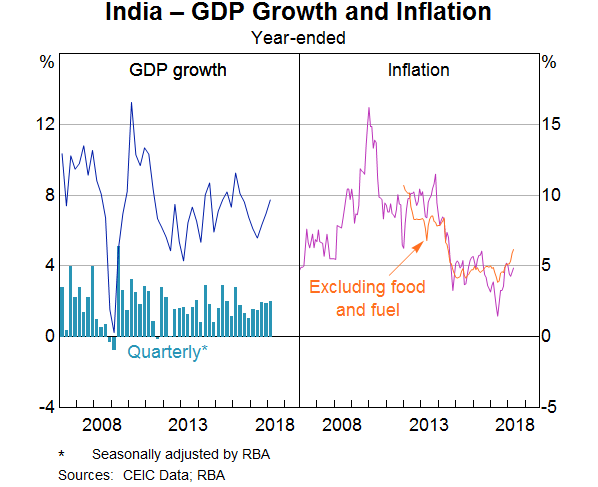
The rapid pace of growth in recent years has seen India become the third largest economy in the world on a purchasing power parity (PPP) basis (International Monetary Fund 2017). While India's importance in global trade has grown over the past few decades, its share remains modest at less than 2 per cent.[1] Nonetheless, the resurgence in domestic demand in recent years has underpinned a rebound in India's imports. Consequently, after declining in importance as a trading partner for Australia between 2009 and 2014, more recently, India has grown in significance as a source of demand for a range of Australian goods and services exports.
This article discusses economic trends in India over the past few years in the context of the longer-term evolution of industrial structure, productivity, demographics and trade. It then examines how Australian–Indian bilateral trade has evolved and considers the scope for bilateral trade to broaden further in the future.
Recent Macroeconomic Outcomes
In the aftermath of the GFC, Indian policymakers faced several challenges. The recovery in domestic demand in 2009, together with a rebound in international oil prices, resulted in a large and persistent increase in inflationary pressures. However, the scope to tighten monetary policy to address inflation appeared limited. By the end of 2012, the Reserve Bank of India (RBI) had already raised its policy interest rate by 325 basis points from its trough and GDP growth had halved from its immediate post-GFC rates (Graph 2). The scope for monetary policy to support growth was also limited; the RBI was concerned that a monetary easing would exacerbate high inflation (RBI 2012).
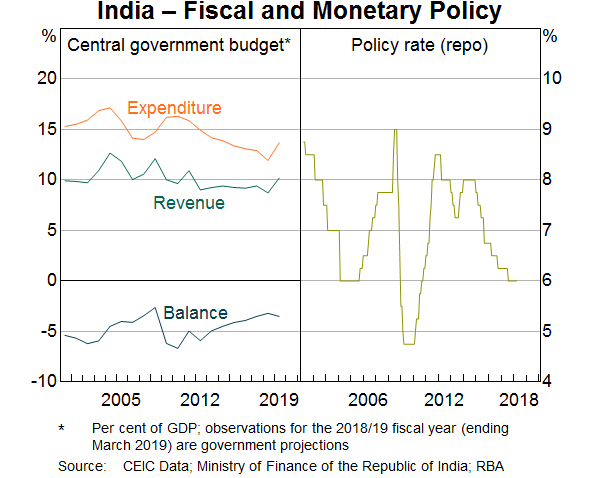
Fiscal policy was also constrained in its ability to support growth. The increase in fiscal spending during the GFC, which was concentrated in higher subsidies for petroleum and food, and wage increases for public servants, had resulted in a notable widening of the budget deficit, to nearly 7 per cent of GDP. Under the Fiscal Responsibility and Budget Management Act 2003, the Indian Government had committed to a consolidation path for the budget, with a target for the fiscal deficit of 3 per cent of GDP. While the target was suspended during the GFC, it was reinstated shortly after, which limited the policy space to support growth.
The rebound in international oil prices that happened in the wake of the GFC worsened the policy dilemma. In general, rising oil prices boosted the relative cost of imports, which lowered India's terms of trade and weighed on growth. The increase in oil prices had several specific consequences. First, it increased the cost of government fuel subsidies and slowed the process of fiscal consolidation. Second, it led to higher consumer price inflation. Third, it boosted the value of the trade deficit. In addition to the direct effects from oil imports, this was partly because soaring inflation suppressed real returns on financial investments and thus led to a dramatic increase in imports of gold jewellery as households searched for higher-yielding places to invest their savings (Basu, Eichengreen and Gupta 2015).
The economic challenges facing the authorities raised concerns among international investors about India's external vulnerabilities. While the persistent negative trade balance, on its own, was not a particular cause for alarm, the expansion of India's current account deficit since the GFC had been funded in part by inflows of short-term portfolio investment (Graph 3). India was one of several emerging economies that attracted increased portfolio flows after the GFC, as investors turned their attention away from lower-yielding investments in advanced economies where central banks had eased policy aggressively to stimulate growth. This contributed to an appreciation of the Indian rupee (INR) and increased the likelihood of a large correction if foreign investment flows into India were to decline.
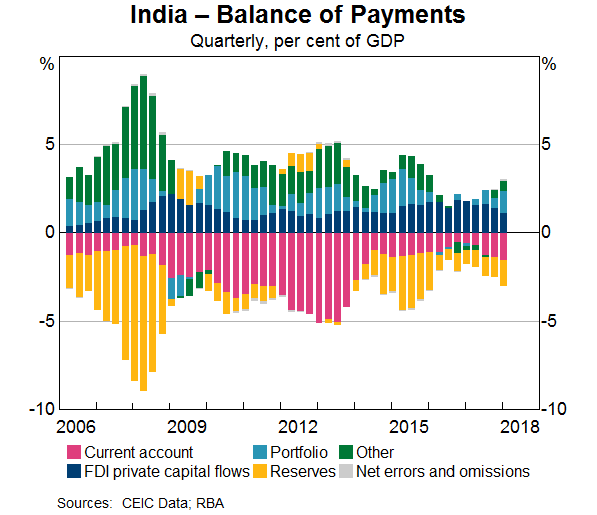
As it happened, the US Federal Reserve's decision to start tapering its bond purchase program in May 2013 resulted in several emerging economies, including India, experiencing sizeable capital outflows and currency depreciations (the so-called ‘taper tantrum’ episode) (Graph 4). While the depreciation of the rupee – in nominal and real trade-weighted terms – improved the competitiveness of India's exports, it exacerbated the inflation problem by boosting import prices and increased the cost of borrowing in foreign currency. The episode prompted investment bank Morgan Stanley to list India among the so-called ‘fragile five’ group of economies.[2] Widespread concern about India's prospects led then Prime Minister Manmohan Singh to give a speech reassuring investors that India was not at risk of repeating the 1991 balance of payments crisis.[3]
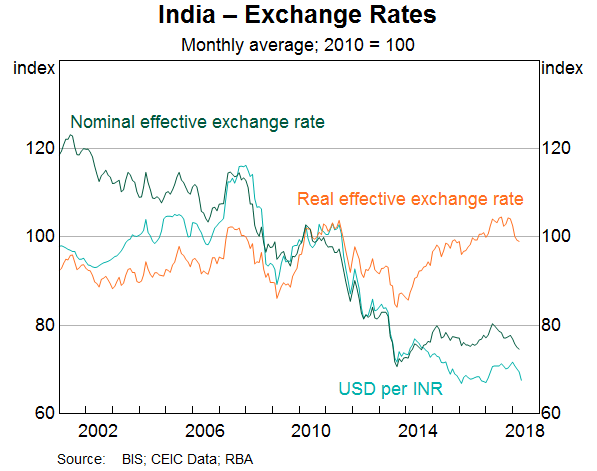
India's policymakers responded to these challenges. The RBI intervened in the foreign exchange market, increased its standing facility rate by 200 basis points and tightened access to liquidity to limit the rupee's depreciation (Patra et al 2016). The RBI also reduced demand pressure in foreign exchange markets by opening a dedicated swap facility for state oil-importing companies and imposed restrictions on capital outflows by corporates and individuals (Basu et al 2015). The exchange rate stabilised as a consequence; in real effective terms, the currency actually appreciated due to high inflation rates in India relative to its trading partners. Meanwhile, to address the widening of the trade deficit, the government increased import duties on gold and gold jewellery three times in 2013 as well as imposing quantitative restrictions on the import of gold items.[4] To lower the budget deficit, the government reduced routine public expenditure (Basri 2017).
The RBI also took action to contain inflation, given concerns that higher inflation expectations would become entrenched. Between May 2013 and early 2014, the RBI raised its policy rate by 75 basis points. Furthermore, the central bank took steps to develop a credible inflation target to lower inflation expectations. After his appointment in September 2013, the new RBI Governor, Dr Raghuram Rajan, announced a review into the RBI's monetary policy framework, led by Dr Urjit Patel (then Deputy Governor). The Patel Committee proposed an interim ‘glide path’ to facilitate a gradual reduction in inflation, followed by the eventual adoption of a flexible inflation-targeting regime with a target consumer price index (CPI) inflation rate of 4 per cent (+/−2 per cent ) over a two-year timeframe. Although inflation targeting was not formally adopted until 2016, the RBI began implementing the glide path in late 2013. This appeared to assist in anchoring inflation expectations, with a steady easing of price pressures across all the major subcomponents of inflation.
A couple of other factors also contributed to stronger economic conditions. Beginning in mid 2014, international oil prices fell sharply, eroding much of the steady increase that had occurred since the GFC. The unwinding of the associated negative terms of trade shock supported growth, while easing pressure on inflation, the budget deficit and the current account. In late 2014, the government of Prime Minister Narendra Modi (elected in April of that year) took advantage of falling global oil prices to abolish diesel subsidies. In addition, the new administration announced measures to boost investment, plans to build national infrastructure, develop capacity in manufacturing and introduce a goods and services tax (GST). The recovery that was already in train, combined with a series of new policy announcements, contributed to a rebound in consumer and business confidence regarding the economy's prospects.
Over the past five years, growth in activity has strengthened further. GDP expanded by 7¼ per cent over 2017 (Graph 5), the highest growth rate of any major economy. The recovery has been driven in large part by stronger growth in investment. Although private investment has been subdued due to constraints on credit supply (partly because of high non-performing loans in the banking system), public investment has grown strongly. The pick-up in public investment has been supported by the government's efforts to progress a large pipeline of infrastructure projects that had stalled due to construction delays, administrative red tape, inadequate financing, legal disputes and difficulty obtaining land for development. Since 2014, the government has attempted to simplify bureaucratic procedures and streamline approvals for investment projects, contribute to financing through public–private partnerships and ease legal constraints.
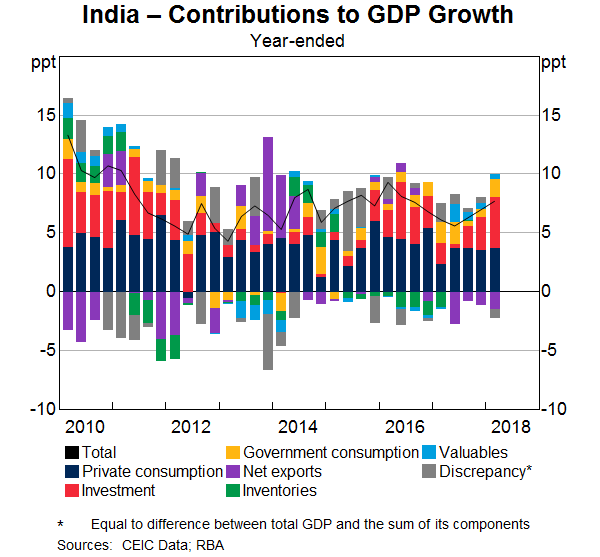
The recent strengthening of domestic demand has boosted imports of both goods and services (Graph 6). Another factor driving higher imports is the partial recovery in oil prices since 2015. The associated modest expansion of the trade deficit has been offset, in part, by an improvement in services exports. Trade in services, in which India has historically maintained a surplus, has long been dominated by information technology services exports. Over the past five years these have stabilised at a share of about 45 per cent of the total. Meanwhile, there has been a notable increase in travel exports, driven by rapid growth in tourism arrivals, and exports of business services – for example, call centres, data management and accounting services.
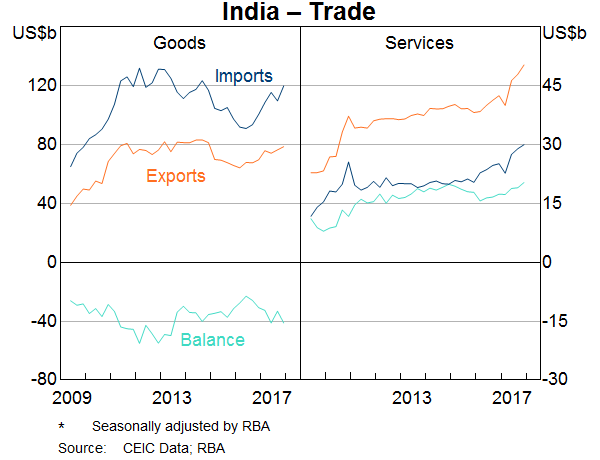
Despite the improvement in economic conditions in recent years, the rebound in global oil prices, combined with a recent moderation in the value of the rupee, pose an upside risk to CPI inflation (which is currently slightly above the RBI's target), and the current account and budget deficits. However, the risk is mitigated by the fact that the current account deficit has increasingly been funded by direct investment, which tends to be more stable than other types of funding. Efforts to phase out fossil fuel subsidies should temper the effect of higher oil prices on government spending and, by supporting fiscal revenue, the introduction of the GST should also help offset negative effects on the budget balance. Although a sharp currency depreciation could worsen the indebtedness of Indian firms that borrow abroad, India's foreign-currency denominated debt remains low by international standards (at less than 10 per cent of GDP). Moreover, the central bank's capacity to manage an increase in currency volatility has improved as a result of the steady increase in the RBI's holdings of foreign exchange reserves since 2014. Thus, while risks remain, the Indian economy is currently in a better position to weather commodity and foreign exchange market fluctuations than was the case at the time of the 2013 taper tantrum.
Longer-term Growth Prospects and the Indian Government's Policy Agenda
The policies of the government and the RBI, combined with the reversal of a negative terms of trade shock, helped the Indian economy to avoid a severe downturn. They also removed some of the obstacles in the way of India realising its high potential for growth. Output per capita in India remains low relative to the advanced economies, and even relative to fast-growing emerging economies such as China (Graph 7). This suggests that there is substantial room for ‘catch-up’ growth to continue to propel the economy forward in coming years.
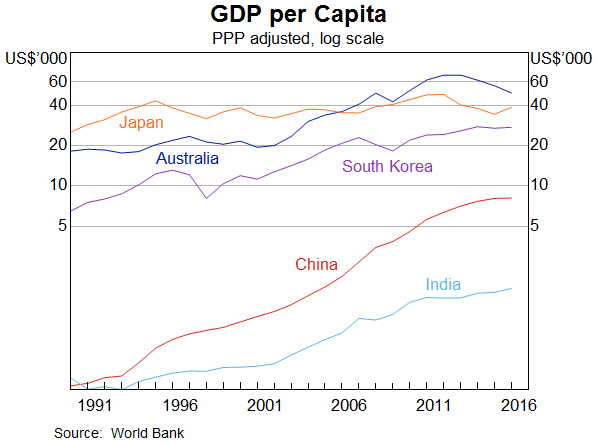
One feature of India's development path so far, compared with many other economies, is the fact that growth has been driven more by the expansion of services than by growth in industrial capacity (Graph 8). This reflects the fact that the manufacturing sector has historically been subject to more stringent and burdensome regulations than the services sector (Cagliarini and Baker 2010). Although the government is working to boost manufacturing capacity, the industrial sector has declined further as a share of the economy's value-added output in recent years. The modest degree of industrialisation to date suggests substantial potential for manufacturing and construction activity to support future growth.
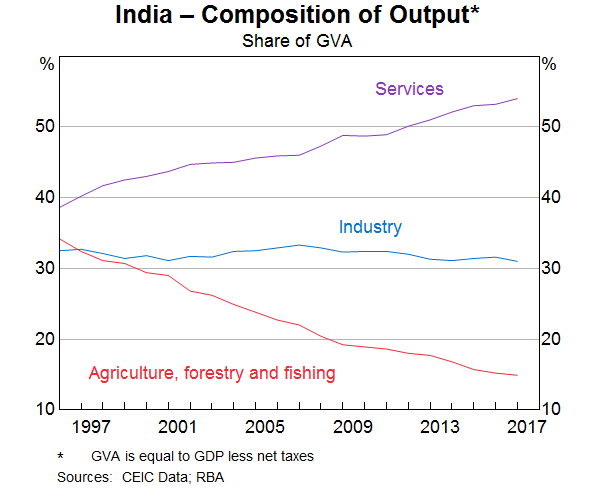
A second distinguishing feature is India's relatively low rate of urbanisation (Graph 9). The proportion of the population living in urban areas has increased steadily over recent decades, but the majority still live in rural areas. The urbanisation rate is likely to continue its upward trajectory, reflecting better economic opportunities in cities, as well as government plans to encourage the development of urban centres. The transfer of people from relatively low-productivity occupations in agriculture to higher-productivity jobs in manufacturing and services represents an additional source of potential growth in the coming decades.

A third characteristic that is likely to support future growth is India's relatively young population (Graph 10). The majority of the population is of working age (15–64 years old), and the United Nations projects the working-age population to continue to grow until around 2050. By comparison, China's working-age population has already peaked. The projected rise in the working-age population implies a gradual decline in the dependency ratio (the share of the population that are children or past retirement age), which should lower the fiscal burden of health, education and aged-care expenses. More generally, it suggests that the economy's aggregate output will continue to expand even if the level of labour productivity is unchanged.
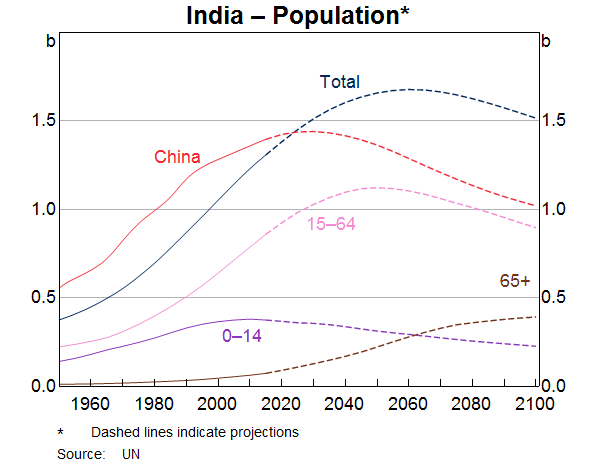
In fact, labour productivity has recorded robust growth in recent years (Graph 11). At least in part, it is likely that this represents the outcome of a series of reforms since the early 1990s that sought to deregulate industrial licensing, privatise state-owned firms and open markets to domestic and international competition (Ahluwalia 2002; Panagariya 2004). This suggests that the future trajectory of productivity growth will partly depend on the success or failure of the current round of government-led reform initiatives.
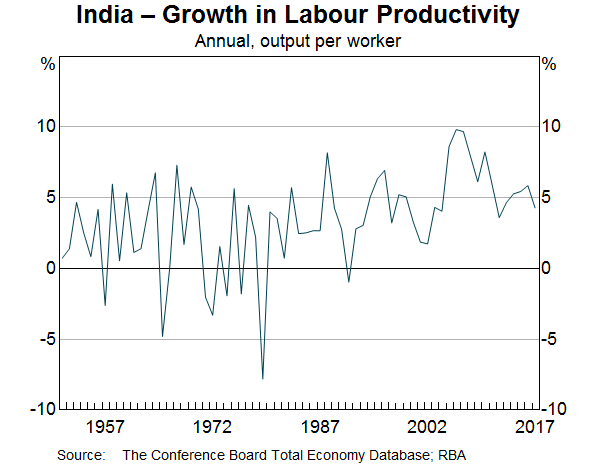
Since forming government in 2014, the Modi administration has introduced a series of policies and reforms that seek to boost investment, strengthen productivity and support the processes of industrialisation and urbanisation. A centrepiece of the government's ambitions – the ‘Make in India’ program, announced in 2014 – seeks to develop India's manufacturing industry, improve the ease of doing business in India and encourage foreign companies to manufacture products locally. To achieve these goals, the government has opened 25 industries to 100 per cent foreign direct investment; initiated programs to construct highways, ports, freight railways and other logistics infrastructure; provided funding support for domestic start-ups; and undertaken infrastructure spending targeted at six ‘corridors’ that connect major Indian cities as nodes in a geographical network of manufacturing hubs.[5]
The administration also introduced a GST in July 2017 to raise productivity and increase fiscal revenue (by reducing tax evasion). The GST replaced central and state taxes that resulted in duplicate taxation and reduced efficiency in numerous ways – for example, many such taxes were levied at state borders, increasing the cost of logistics and interstate transportation. The removal of these distortions should help to support growth in coming years. Despite fears that the GST would harm near-term economic prospects, its introduction caused only modest short-term disruption to economic activity and, aside from a spike in the monthly CPI in July 2017, inflation has not been noticeably affected.
In addition, the government has introduced a number of financial reforms to address the problem of bad debts in the banking system, which is widely thought to have dampened the supply of credit and weighed on growth in private investment. In May 2016, the government passed the Insolvency and Bankruptcy Code 2016 that consolidated existing legislation into a single code, clarifying the law and imposing a time limit of 270 days for the resolution of cases (Ministry of Finance 2016). A recapitalisation plan announced in October 2017 seeks to replenish the capital of public sector banks (which account for more than 70 per cent of the banking system). Collectively, these initiatives may make it easier for bad debts to be recovered, relieve pressure on banks with high levels of stressed loans, and thereby improve incentives for banks to extend credit to the corporate sector.[6]
In other areas, the government's reform agenda has faced roadblocks. For example, reforms to make it easier for land to be acquired for investment purposes have prompted legal challenges, forcing the central government to leave the burden of land reform to be assumed by state governments.[7] The government has also faced legal challenges in efforts to introduce a national identity card (Aadhaar) system, whereby Indian residents are assigned a unique 12 digit identity number, which is linked to biometric and demographic data. The program is designed to reform the government's welfare programs by allowing subsidy payments, pensions and unemployment benefits to be credited directly to individuals' bank accounts. This is intended to reduce tax fraud and increase financial inclusion. Although parliament has passed the legislation, its legality has been challenged on privacy grounds in the Supreme Court.
Complementing the ‘big bang’ reforms outlined above, the administration has taken steps to increase productivity in more incremental ways through changes in routine government procedures to streamline approvals for investment projects, reduce the burden of regulation on businesses and tackle official corruption. The government has made a number of interventions to cut red tape – for example, reducing the discretion of federal labour inspectors, rationalising the numerous overlapping labour regulations that employers were required to comply with, and simplifying environmental approval procedures for investment.[8] Several measures have been adopted to reduce corruption, such as restricting the access of lobbyists to government officials (Gupta and Gupta 2015).
Although the reform agenda has experienced setbacks and delays, it has probably contributed to stronger public investment and a strengthening of business confidence. India's ranking in the World Bank's ‘Ease of Doing Business’ index increased to 100th in 2017 from 130th in 2016, a development cited by the government as evidence of the success of its reform program (PMINDIA 2017; World Bank 2017).
The recovery in Indian imports in recent years has been mirrored in bilateral trade flows between India and Australia, which raises the question of whether this trend will continue. In the future, policies to accelerate urbanisation and industrialisation, if successful, are likely to boost India's demand for raw materials used in the steelmaking process – iron ore and coking coal – including from Australia. Rising per capita incomes can also be expected to support demand for imported services such as tourism and education, which Australia already exports to India.
Australian–Indian Bilateral Trade and Future Prospects
Australia's bilateral trade with India has grown significantly over the past two decades. This partly reflects ongoing trade reform in India, which has increased the openness of its economy. In 2017, total goods and services trade between Australia and India was worth over $27 billion, up from $2.7 billion in 1999. This compares with $183 billion in total goods and services trade with China in 2017.
India is the fourth largest destination for Australian exports, accounting for more than 5 per cent of total goods and services exports by value in 2017. Coal exports have been the largest category of Australian exports to India over the past two decades, accounting for 46 per cent of total goods and services exports (Table 1). After peaking in 2010, exports to India declined sharply, reflecting the stagnation of Indian coal demand and a slowdown in education exports (Graph 12). However, exports have recovered in the past three years, reflecting a broad-based recovery across goods and services, spurred by the recovery in Indian domestic demand.
Australian imports from India are relatively small; India is Australia's twelfth largest import source. The largest import categories are refined petroleum, travel (mainly tourism) and business services.
| Exports to India | Value | Per cent of total exports | Imports from India | Value | Per cent of total imports |
|---|---|---|---|---|---|
| Coal | 9,181 | 46 | Refined petroleum | 1,554 | 21 |
| Travel | 4,151 | 21 | Travel | 1,059 | 15 |
| Vegetables | 1,377 | 7 | Professional, technical and other business services | 1,010 | 14 |
| Gold | 689 | 3 | Pharmaceuticals (inc. veterinary) | 335 | 5 |
| Copper | 688 | 3 | Pearls and gems | 274 | 4 |
| Total | 20,157 | Total | 7,267 | ||
|
Sources: ABS; RBA |
|||||
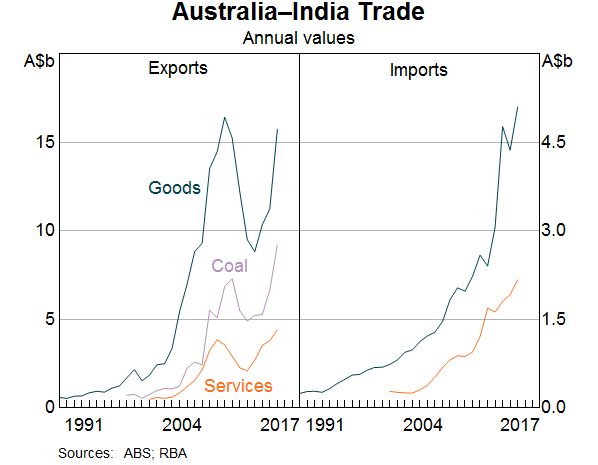
Despite strong growth in recent decades, considerable potential exists for trade between Australia and India to expand further. Since 2011, Australia and India have periodically convened negotiations to conclude a Comprehensive Economic Cooperation Agreement to reduce barriers to trade in goods and services. While there have been no new bilateral free trade negotiations since September 2015, both countries have been engaged in the Regional Comprehensive Economic Partnership negotiations, a proposal for an ASEAN-centred regional free trade area. The Australian Government has recognised the potential to strengthen the bilateral relationship; in April 2017, Prime Minister Malcolm Turnbull announced the ‘India Economic Strategy’ (Department of Foreign Affairs and Trade 2017), an independent report providing advice on how to develop Australia's bilateral economic relationship with India out to 2035.
India's demand for resource commodities, in particular, is likely to rise as industrialisation and urbanisation continue over the next few decades. The Indian Government has forecast that domestic steel production will increase to 300 million tonnes by 2030, more than triple its current production (Ministry of Steel 2017). The projected growth in Indian steel output is likely to support demand for iron ore and coking coal.
India's coking coal reserves are small and tend to be of relatively low quality due to their high ash content (Department of Industry and Science 2015). This has resulted in India importing the bulk of its coking coal requirements, of which 80 per cent are already sourced from Australia. Although the Indian Government has prioritised research and development seeking to reduce the use of coking coal in the steelmaking process (Ministry of Steel 2017), Australian coking coal exports to India are likely to continue to grow strongly given the expected growth in steel production.
With regard to iron ore, India is already largely self-sufficient and possesses large high-quality iron ore reserves (Indian Bureau of Mines 2018). Projections by Australia's Department of Industry, Innovation and Science suggest that India may not be able to increase production at a sufficient rate to meet forthcoming demand arising from steel production (DOIIS 2017, p 121). However, the Indian Government has recently eased mining bans and export taxes that were in place between 2010 and 2012 (USGS 2016). If these spur a revival in domestic production, they may reduce the potential for Australian exports to be required to meet India's demand for iron ore.
Any further expansion of Australia's resource trade with India will take time. One reason is that India's pattern of urbanisation to date has been quite different from Australia's largest trading partner, China. Notably, the proportion of dwellings made in India using steel-reinforced concrete is much smaller than in China, reflecting the large proportion of the population still living in rural areas (D'Arcy and Veroude 2014). For coal, another reason is that the Indian Government has a policy goal of self-sufficiency in coal production (Goyal 2016). Coal currently accounts for 44 per cent of primary energy demand and this share has risen over time as households have transitioned from the use of traditional biomass (wood, straw, charcoal and dung) (IEA 2015). In keeping with India's carbon dioxide emission reduction commitments, the government's Draft National Electricity Plan projects a strong increase in energy derived from renewable sources (Ministry of Power 2016). However, the Draft National Energy Policy projects that thermal coal will remain the dominant source of energy, at 48–58 per cent of primary energy consumption by 2040, and that it will be supplied almost entirely by India itself by that date (NITI Aiyog 2017). The policy projects that India's annual thermal coal production capacity will peak at 1.2–1.3 billion tonnes in 2037.
Australian services are the second largest category of exports to India, accounting for just under a quarter of total exports. In 2016, two-thirds of total services exports came from education services (which account for the majority of travel exports in Table 1). India is the second largest source of international student enrolments in higher education in Australia (Graph 13). The number of students from India enrolled in higher education in Australia has trended higher over time, except for a period of decline between 2009 and 2012, following widespread local and foreign media coverage of incidents of violence against Indians, including students, living in Australia.[9]
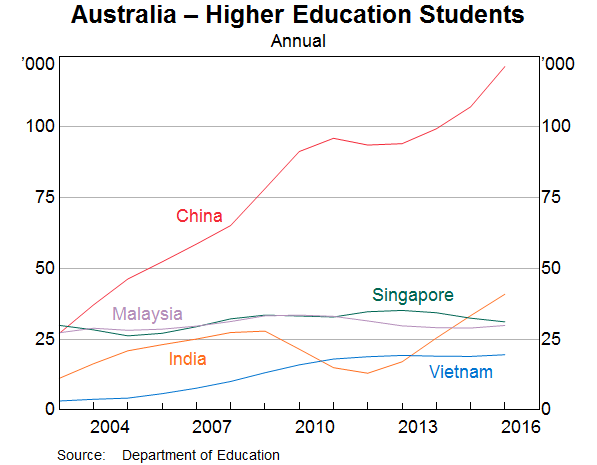
However, since 2012, Indian student enrolments in Australia have grown rapidly, in part because Australian universities have begun to collaborate with Indian institutions to develop joint study programs and research institutes.[10] The number of Indian students studying in Australia is likely to continue increasing as the demand for skilled workers to support India's economy grows. As part of its ‘Skill India’ initiative – which was launched in 2015 and seeks to take advantage of the young demographic profile of India – the Indian Government has set a target of upskilling 400 million people by 2022 (Ministry of Skill Development and Entrepreneurship 2015).
Agricultural trade with India may also afford opportunities for Australian exporters in the years ahead. Sustained growth in agricultural output over the past few decades has enabled India to become a net exporter of agricultural products. Yet India's crop output is highly sensitive to its monsoon season and other weather events, so imports are often required to supplement domestic supply. Australian exports of pulses to India have increased significantly over the past decade, as the Indian Government has reduced import duties to ensure domestic supply. As India continues to grow, there is potential for these exports to expand further to help India improve its food security. However, the Indian Government has also used trade policy in the past to support its farmers, creating uncertainty for exporters.[11]
Conclusion
The Indian economy has strengthened steadily in recent years, emerging relatively unscathed from bouts of volatility associated with the GFC and the 2013 ‘taper tantrum’. A combination of policy reform and the reversal of a negative terms of trade shock have helped the Indian economy realise its strong potential for growth, underpinned by a rising working-age population and rapid growth in labour productivity. The government's economic reform program, which is targeted at facilitating urbanisation and expanding the manufacturing sector, has supported a rebound in business confidence and stronger growth in investment. Despite the recent increase in crude oil prices and the depreciation of the rupee, the Indian economy is therefore in a better position today than it was several years ago.
As domestic economic conditions have improved, they have in turn driven a recovery in India's imports and a pick-up in Australia's exports to India of both goods and services. In the future, domestic policies in India (such as a focus on self-sufficiency in coal production) may limit the scope for growth in certain types of bilateral trade. However, the potential for future growth, and the existing trade relationship in areas such as education services and agricultural products, suggest that Australia could benefit from expanded trade in goods and services with India in coming years.
Footnotes
June Ma is in Financial System Group and Ivan Roberts is in Economic Group. [*]
In 2016, India accounted for 1.8 per cent of the value of global merchandise exports and 1.5 per cent in the case of merchandise imports (World Bank 2018). [1]
See Morgan Stanley (2013). The ‘fragile five’ referred to Brazil, India, Turkey, South Africa and Indonesia, which at the time were seen by some private sector commentators to be among the emerging economies most vulnerable to depreciation because of the withdrawal of quantitative easing policies in the United States and other advanced economies. [2]
See Reuters (2013). [3]
Basu et al (2015) question the effectiveness of the use of import duties on gold during this episode. [4]
The related ‘Smart Cities Mission’ program encourages cities to compete for public and private funding to spur investment in infrastructure and urban renewal, while the ‘Digital India’ initiative further aims to increase access to high-speed internet, including in rural areas, and support digital delivery of government services. [5]
Another high-profile reform was the ‘demonetisation’ program, enacted in late 2016, whereby high-denomination banknotes were suddenly withdrawn from circulation. The program was directed at reducing the incidence of so-called ‘black money’ (associated with the informal economy and illegal activities) and counterfeiting, as well as lowering reliance on cash. The program resulted in a large but temporary contraction in the total currency in circulation. While the number of non-cash payments has subsequently increased, the Indian economy is still largely reliant on cash, and the total currency in circulation currently exceeds its level before the reform. [6]
In particular, the government sought to amend the Land Acquisition, Rehabilitation and Resettlement Act 2013 to remove majority landowner consent provisions, social impact assessment requirements and restrictions on land acquisition by private entities. While the bill passed the lower house of parliament in 2015, it was blocked by the upper house. [7]
For examples of these initiatives, see Mandhala (2014), Dhoot (2014), Bhan (2017) and Singh (2016). [8]
For example, see Mason (2012). [9]
For example, the University of Melbourne and Monash University offer joint PhD programs with Indian institutions, and Monash University has established a Research Academy in north-eastern Mumbai in partnership with the Indian Institute of Technology Bombay. [10]
For example, in December 2017, a tariff was placed on imports of chickpeas and lentils due to an abundance of domestic supply. Chickpea exports to India were $1.1 billion in 2016/17. By volume, India accounts for around 80 per cent of Australian chickpea exports. [11]
References
Ahluwalia MS (2002), ‘Economic Reforms in India Since 1991: Has Gradualism Worked?’, Journal of Economic Perspectives, 16 (3), pp 67–88.
Basri MC (2017), ‘India and Indonesia: Lessons Learned from the 2013 Taper Tantrum’, Bulletin of Indonesian Economic Studies, 53(2), pp 137–60.
Basu K, B Eichengreen and P Gupta (2015), ‘From Tapering to Tightening: The Impact of the Fed's Exit on India’, India Policy Forum, 2014–15 (11), pp 1–66.
Bhan I (2017), ‘Ease of Compliance Rules: How Narendra Modi Government's Move Will Help Establishments Cut Costs and Effort’, Financial Express, 5 May. Available at <http://www.financialexpress.com/economy/ease-of-compliance-rules-how-narendra-modi-governments-move-will-help-establishments-cut-costs-and-effort/654681/>.
Cagliarini A and M Baker (2010), ‘Economic Change in India’, RBA Bulletin, September, pp 19–24.
D'Arcy P and A Veroude (2014), ‘Housing Trends in China and India’, RBA Bulletin, March, pp 63–68.
Department of Industry and Science (2015), ‘Coal in India’, June. Available at <https://www.industry.gov.au/Office-of-the-Chief-Economist/Publications/Documents/Coal-in-India.pdf>, p 45.
DOIIS (Department of Industry, Innovation and Science) (2017), Resources and Energy Quarterly, September. Available at <https://www.industry.gov.au/Office-of-the-Chief-Economist/Publications/ResourcesandEnergyQuarterlySeptember2017/index.html>.
Department of Foreign Affairs and Trade (2017), ‘Joint Statement by Prime Minister Turnbull and Prime Minister Modi, visit to India 2017’, 10 April. Available at <http://dfat.gov.au/geo/india/Pages/joint-statement-by-prime-minister-turnbull-and-prime-minister-modi-visit-to-india-2017.aspx>.
Dhoot V (2014), ‘Modi Government Cuts Through Red Tape to Make Working Easier in India’, The Economic Times, 17 October. Available at <https://economictimes.indiatimes.com/news/economy/policy/modi-government-cuts-through-red-tape-to-make-working-easier-in-india/articleshow/44842892.cms>.
Goyal P (2016), ‘Energy Security Is an Integral Part of National Security’, Mumbai, 30 September. Available at <http://pibmumbai.gov.in/scripts/detail.asp?releaseId=E2016PR1948>.
Gupta S and S Gupta (2015), ‘Top-level Corruption's Down in Modi Govt, Fingers Crossed: India Inc’, The Times of India, 22 February. Available at <https://timesofindia.indiatimes.com/india/Top-level-corruptions-down-in-Modi-govt-fingers-crossed-India-Inc/articleshow/46328407.cms>.
Indian Bureau of Mines (2018), ‘Iron & Steel and Scrap’, Indian Minerals Yearbook 2017, March. Available at <http://ibm.nic.in/writereaddata/files/03232018160231Iron%20Steel%20Scrap_AR_2017.pdf>.
IEA (International Energy Agency) (2015), India Energy Outlook, International Energy Agency, Paris.
IMF (International Monetary Fund) (2018). ‘GDP based on PPP, share of world’, Available at < http://www.imf.org/external/datamapper/NGDPDPC@WEO/OEMDC/ADVEC/WEOWORLD>.
World Bank (2017), ‘India Jumps Doing Business Rankings with Sustained Reform Focus’, Press Release, 31 October. Available at < http://www.worldbank.org/en/news/press-release/2017/10/31/india-jumps-doing-business-rankings-with-sustained-reform-focus>.
Mandhana N (2014), ‘India Takes on Bureaucratic Red Tape with Series of Changes’, Wall Street Journal, 16 October. Available at <https://www.wsj.com/articles/india-takes-on-bureaucratic-red-tape-with-series-of-changes-1413476879>.
Mason G (2012), ‘“I am tomorrow”: Violence against Indian students in Australia and political denial’, Australian and New Zealand Journal of Criminology, 45(1), pp 4–25.
Ministry of Skill Development and Entrepreneurship (2015), ‘National Policy for Skill Development and Entrepreneurship’. Available at <http://www.skilldevelopment.gov.in/assets/images/Skill%20India/National%20Policy%20on%20Skill%20Development%20and%20Entreprenurship%20Final.pdf>.
Ministry of Power of the Republic of India, ‘Draft National Electricity Plan’, December. Available at <http://www.cea.nic.in/reports/committee/nep/nep_dec.pdf>.
Ministry of Steel of the Republic of India (2017), ‘Research and Development in Iron and Steel Sector’, 24 October. Available at <http://steel.gov.in/technicalwing/research-development-iron-steel-sector>.
Ministry of Steel of the Republic of India (2017), ‘Research and Development in Iron and Steel Sector’, 24 October. Available at <http://steel.gov.in/sites/default/files/policy1_0.pdf>.
Morgan Stanley (2013), ‘Global EM Investor: The Fragile Five’, Morgan Stanley Research Report, New York, 5 August. Available at <http://graphics8.nytimes.com/packages/pdf/business/MorganStanleyFragileFive.pdf>.
NITI Aayog (Government of India) (2017), ‘Draft National Energy Policy’, 27 June. Available at <http://niti.gov.in/writereaddata/files/new_initiatives/NEP-ID_27.06.2017.pdf>.
Panagariya A (2004), ‘Growth and Reforms during the 1980s and 1990s’, Economic & Political Weekly, 39(25), pp 2581–2594.
Patra MD, S Pattanaik, J John and HK Behera (2016), ‘Global Spillovers and Monetary Policy Transmission in India’ Reserve Bank of India Working Paper Series 03/2016. Available at < https://rbi.org.in/scripts/PublicationsView.aspx?Id=16734>.
PMINDIA (2017), ‘PM Hails India's Historic Jump in ‘Ease of Doing Business’ Rankings’, 31 October. Available at <http://www.pmindia.gov.in/en/news_updates/pm-hails-indias-historic-jump-in-ease-of-doing-business-rankings/>.
RBI (Reserve Bank of India) (2012), ‘Mid-Quarter Monetary Policy Review: September 2012’. Available at <https://www.rbi.org.in/scripts/BS_PressReleaseDisplay.aspx?prid=27222>.
RBI (2014), ‘Report of the Expert Committee to Revise and Strengthen the Monetary Policy Framework’, January.
Reuters (2013), ‘India Not Headed Back to 1991 Crisis: Manmohan Singh’, 30 August. Available at <https://www.reuters.com/article/us-india-economy-crisis/india-not-headed-back-to-1991-crisis-manmohan-singh-idUSBRE97T08S20130830>.
USGS (United States Geological Survey) (2016), 2013 Minerals Yearbook: India [Advanced Release], May. Available at <https://minerals.usgs.gov/minerals/pubs/country/2013/myb3-2013-in.pdf>.
World Bank (2018), ‘Top Importers and Exports 2016’, 14 May. Available at <https://wits.worldbank.org/CountryProfile/en/Country/WLD/Year/2016/TradeFlow/EXPIMP>.